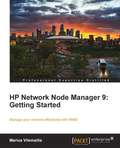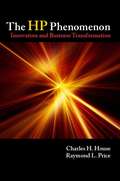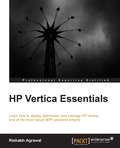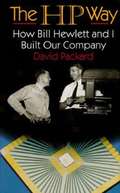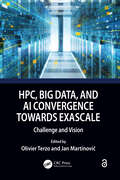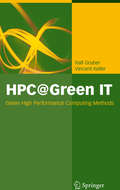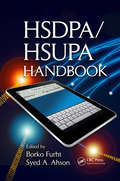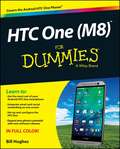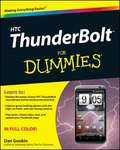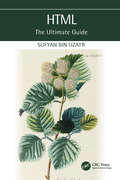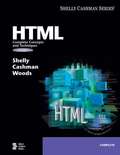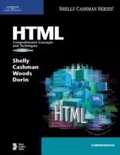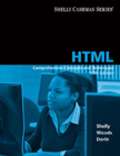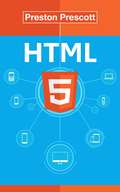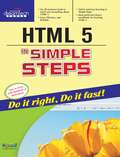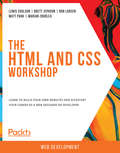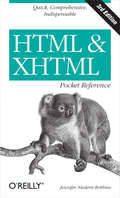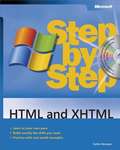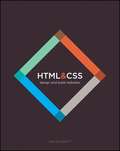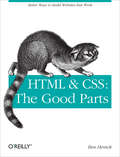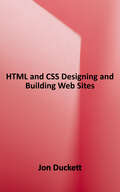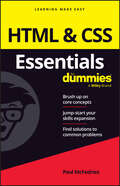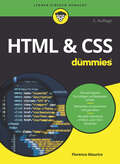- Table View
- List View
HP Network Node Manager 9: Getting Started
by Marius VilemaitisThis book is a step-by-step guide describing how to implement, maintain, and expand the NNMi management tool. It is a practical guide, based on experience managing networks in a wide scale of network operation centers. It shares best practices and explains a lot of non-technical issues that arise during implementations and operations. Each topic has practical examples where the reader can practice while reading the book.The book is written for the following audience:Monitoring solution designers, who plan how to implement NNMi Network engineers, who plan to start managing their network System administrators, who start administering NNMi Network monitoring operators, who want to learn how to use NNMi If you belong to any one of the above professions, then this book is for you. It's also for professionals who describe themselves as beginners, or intermediate-level professionals. The book is also suitable for old-version NNM users who wish to switch to NNMi.
The HP Phenomenon
by Charles H. House Raymond L. PriceCo-authored by Charles House, the only person in the history of Hewlett-Packard (HP) to win the company's Award for Meritorious Defiance (1982), this book explains the philosophies, practices, and organizational principles behind the company's six transformations. The book chronicles the growth of the company from $98 million in 1962 to $9. 8 billion currently, looking at products from an engineering perspective and looking at human issues from a manager's perspective. The audience for the book includes engineers, managers, and organizational leaders. House is senior research scholar in the Human Science and Technologies Advanced Research Institute at Stanford University. Price is professor of human behavior in engineering at the University of Illinois-Urbana-Champaign. Both authors have held management positions at Hewlett-Packard. Stanford Business Books is an imprint of Stanford University Press. Annotation c2010 Book News, Inc. , Portland, OR (booknews. com)
HP Vertica Essentials
by Rishabh AgrawalThis is a step-by-step guide with an easy-to-follow approach. A variety of diagrams and images support the concepts explored in the book. This book also contains important tips and tricks, thus making it a really useful reference for Vertica administration activities. If you are a Vertica user or DBA who wants to perform basic administration and fi ne tuning, then this book is for you. Prior knowledge of Vertica will help you to understand the concepts better, but is not mandatory. Some intermediate knowledge of RDBMS, SQL, Linux, and scripting languages such as Perl or Python will be helpful.
The HP Way: How Bill Hewlett and I Built Our Company
by David PackardIn the fall of 1930, David Packard left his hometown of Pueblo, Colorado, to enroll at Stanford University, where he befriended another freshman, Bill Hewlett. After graduation, Hewlett and Packard decided to throw their lots in together. They tossed a coin to decide whose name should go first on the notice of incorporation, then cast about in search of products to sell. Today, the one-car garage in Palo Alto that housed their first workshop is a California historic landmark: the birthplace of Silicon Valley. And Hewlett-Packard has produced thousands of innovative products for millions of customers throughout the world. Their little company employs 98,400 people and boasts constantly increasing sales that reached $25 billion in 1994. While there are many successful companies, there is only one Hewlett-Packard, because from the very beginning, Hewlett and Packard had a way of doing things that was contrary to the prevailing management strategies. In defining the objectives for their company, Packard and Hewlett wanted more than profits, revenue growth and a constant stream of new, happy customers. Hewlett-Packard's success owes a great deal to many factors, including openness to change, an unrelenting will to win, the virtue of sustained hard work and a company-wide commitment to community involvement. As a result, HP now is universally acclaimed as the world's most admired technology company; its wildly successful approach to business has been immortalized as "The HP Way".
HPC, Big Data, and AI Convergence Towards Exascale: Challenge and Vision
by Olivier TerzoHPC, Big Data, AI Convergence Towards Exascale provides an updated vision on the most advanced computing, storage, and interconnection technologies, that are at basis of convergence among the HPC, Cloud, Big Data, and artificial intelligence (AI) domains. Through the presentation of the solutions devised within recently founded H2020 European projects, this book provides an insight on challenges faced by integrating such technologies and in achieving performance and energy efficiency targets towards the exascale level. Emphasis is given to innovative ways of provisioning and managing resources, as well as monitoring their usage. Industrial and scientific use cases give to the reader practical examples of the needs for a cross-domain convergence. All the chapters in this book pave the road to new generation of technologies, support their development and, in addition, verify them on real-world problems. The readers will find this book useful because it provides an overview of currently available technologies that fit with the concept of unified Cloud-HPC-Big Data-AI applications and presents examples of their actual use in scientific and industrial applications.
HPC@Green IT
by Ralf Gruber Vincent Keller Erich StrohmaierThe authors present methods to reduce computer energy consumption by means of a better usage of a specific set of resources and maximizing the efficiency of the running applications. The processor frequency is adjusted to the needs of the running job, leading to a power drop by a factor of 2 and doubling battery life time of laptops. It is shown how computer resources can be optimally adapted to application needs, reducing job run time. Examples on how to optimize algorithms on single node and parallel RISC architectures are discussed. The job-related data are stored and reused to help computer managers to replace machines.
HSDPA/HSUPA Handbook
by Borko Furht Syed A. AhsonHigh Speed Packet Access (HSPA) is a collection of two mobile telephony protocols, High Speed Downlink Packet Access (HSDPA) and High Speed Uplink Packet Access (HSUPA). Allowing networks based on the Universal Mobile Telecommunications System to achieve data rates of several megabits per second, these powerful protocols are ideal for applications
HTC One (M8) For Dummies
by Bill HughesGet the most out of your HTC One (M8) smartphoneHTC One (M8) For Dummies is a practical user's guide to the HTC One (M8) device, covering a range of pragmatic and how-to topics, from the most useful features and tricks of the core applications to techniques to get the most out of your smartphone. Approaching the capabilities of the HTC One (M8) from the point of view of a user who is intimidated by the technology, and perhaps a bit baffled by the documentation and online support that come with the phone, this handy guide covers all aspects of the HTC One (M8) in a familiar and friendly tone.Inside, you'll find trusted and easy-to-follow guidance on everything needed to optimize your experience with your new HTC One (M8) device: setting-up and configuring your phone; staying in touch with texting, e-mailing, and social networking; surfing the web; getting around with maps and navigation; capturing memories with photos and videos; kicking back with movies; loading up on apps; synching with a PC; and so much more.Clearly explains how to integrate e-mail and social networking on one screenDemonstrates why the HTC One (M8) is getting rave reviews, thanks to its amazing camera and video capabilities, battery life, form and function, and overall fantastic benchmarksShows you how to set up and configure the HTC One (M8)Walks you through expanding your phone's potential with new software releasesDon't let the intimidation of technology get the best of you--let HTC One (M8) For Dummies maximize the performance of your awesome new smartphone.
HTC ThunderBolt For Dummies
by Dan GookinFull-color guide to the exciting HTC Droid ThunderBolt! Now that you've got your high-powered new HTC ThunderBolt smartphone, you've got to figure out how to use it! If you're more than a little intimidated by the technology and somewhat put off by the formal documentation, this book can help. Written in the fun but clear and thorough For Dummies style, this book answers all your questions about Verizon's first 4G LTE Android device and helps you get the very most out of it. Helps you get up to speed quickly on how to use the ThunderBolt smartphone Delves into the basics?how the technology works, how to configure everything, and how to purchase apps through the Android Market or Verizon's AppSphere Delivers a full slate of how-tos, tricks, features, and techniques, all in full color Covers everything you need to know, including setup and configuration, texting, e-mailing, accessing the Internet, maps, navigation, camera, video, and synching with a PC Shows you how to customize your HTC ThunderBolt, how to maintain it, and how to expand or upgrade it with new software Once you learn all the bells and whistles, you'll be overjoyed with your new Android device. The fun starts with HTC ThunderBolt For Dummies.
HTML: The Ultimate Guide (The Ultimate Guide)
by Sufyan bin UzayrHTML code is a programming language used in website building and website templates. It is used to format the look and format of a web page, to set design features such as basic layout, colors, and fonts. HTML: The Ultimate Guide provides a crash course in HTML, its history, key features, different versions available, various tags and elements, as well as the advantages and disadvantages. This book also covers the fundamental concepts of CSS and JavaScript and guides the reader through creating websites and games with these tools. As the reader progresses through the lessons, they will learn how to insert JavaScript commands directly into the HTML document, and how the script executes when viewed in browser. This is a valuable resource for anyone who wants to create a website or any 2D or 3D game in HTML. After finishing this book, readers will be able to quickly build their website or game with absolute ease. This book: Discusses code optimization in HTML code, Web Scripting and Security ideas in HTML. Introduces HTML for Game Development, benefits and types of games (2D and 3D). Includes a Cheat Sheet of HTML where you will get all key terms and useful information that is easy to access.
HTML: Complete Concepts and Techniques
by Gary B. Shelly Thomas J. Cashman Denise M. WoodsPart of the highly successful Shelly Cashman series, this introductory text leads the user through a clear, step-by-step, screen-by-screen approach to learning HTML. Readers learn how to create a Web page using HTML, format the page, add graphics, and more with this exciting new edition.
HTML: Comprehensive Concepts and Techniques
by Gary B. Shelly Thomas J. Cashman Denise M. Woods William J. DorinPart of the highly successful Shelly Cashman series, this introductory text leads the user through a clear, step-by-step, screen-by-screen approach to learning HTML. Readers learn how to create a Web page using HTML, format the page, add graphics, and more.
HTML: Comprehensive Concepts and Techniques
by Gary B. Shelly Denise M. Woods William J. DorinPart of the highly successful Shelly Cashman series, this text provides a comprehensive introduction to HTML and leads the user through a clear, step-by-step, screen-by-screen approach to learning. Readers learn how to create a Web page using HTML, format the page, add graphics, and more.
HTML 5
by Preston Prescott Eleonora BaronScoprite le novità di HTML Grazie a questo libro scoprirete le basi di HTML 5 e come utilizzarlo. Se conoscete già le precedenti versioni di HTML, in special modo HTML 4, imparare a usare HTML 5 sarà un gioco da ragazzi. HTML 5 è la versione più recente dell' Hypertext Markup Language, tuttavia ha mantenuto svariate caratteristiche di HTML 4 e persino di XHTML. Cosa scoprirete leggendo questo volume? *Le differenze tra HTML 4 e 5 *La struttura dei documenti HTML 5 *Come gestire titoli, paragrafi, elenchi, tabelle e form *Come gestire i link e le immagini *Come incorporare contenuti complessi, citazioni, video e audio *Come formattare le vostre pagine web nel modo più accattivante ed efficace Volete saperne di più? Scaricate subito la vostra copia!
HTML 5
by Preston Prescott Paulo Alexandre F. M. TorresDescubra o que há de novo em HTML 5 Neste livro, irá descobrir o básico do HTML 5 e como funciona. Se já estiver familiarizado com outras versões do HTML, especialmente o HTML 4, então aprender HTML 5 será muito fácil para si. O HTML 5 é a última versão da Linguagem Markup de Hipertexto, no entanto incorpora várias caraterísticas do HTML 4 e mesmo do XHTML.
HTML 5
by Preston Prescott Álvaro Gutiérrez SánchezEn este libro, vas a descubrir los fundamentos de HTML 5, así como su funcionamiento. Descubre las novedades de HTML 5 En este libro, vamos a aprender los conceptos básicos de HTML 5, que es un lenguaje de marcado, así como su funcionamiento. Si ya has trabajado con otras versiones de HTML, y especialmente si lo has hecho con HTML 4, entonces dominar HTML 5 te resultará pan comido. HTML 5 es la última versión del Lenguaje de Marcado de Hipertexto (HTML, del inglés Hypertext Markup Language), e incorpora varias características que ya estaban presentes en HTML 4 e incluso en XHTML (la tercera versión). Qué vas a aprender con este libro: Las diferencias entre HTML 4 y HTML 5 Cómo es la estructura de un documento HTML 5 Párrafos y encabezados en HTML 5 Cómo dar formato al texto y crear listas en HTML 5 Cómo crear tablas de contenido en HTML 5 Cómo insertar formularios en HTML 5 Cómo añadir hipervínculos en HTML 5 Cómo añadir imágenes Cómo añadir videos y audio Estructura interna de una página web Cómo trabajar con elementos de cita, iframe, y caracteres especiales Y mucho más ¿Quieres aprender todo esto? Date prisa...Puedes descargar tu copia de "HTML 5" con un precio especial de $2,99, solo por tiempo limitado. ¡Descarga ahora tu copia! Sube al inicio de la página y haz clic en el botón de Comprar
The HTML and CSS Workshop: A New, Interactive Approach to Learning HTML and CSS
by Rob Larsen Lewis Coulson Brett Jephson Matt Park Marian ZburleaCut through the noise and get real results with a step-by-step approach to learning HTML and CSS programming Key Features An HTML and CSS tutorial with step-by-step exercises and activities Structured to let you progress at your own pace, on your own terms Use your physical print copy to redeem free access to the online interactive edition Book Description You already know you want to learn HTML and CSS, and a smarter way to learn HTML and CSS is to learn by doing. The HTML and CSS Workshop focuses on building up your practical skills so that you can build your own static web pages from scratch, or work with existing themes on modern platforms like WordPress and Shopify. It's the perfect way to get started with web development. You'll learn from real examples that lead to real results. Throughout The HTML and CSS Workshop, you'll take an engaging step-by-step approach to beginning HTML and CSS development. You won't have to sit through any unnecessary theory. If you're short on time you can jump into a single exercise each day or spend an entire weekend learning about CSS pre-processors. It's your choice. Learning on your terms, you'll build up and reinforce key skills in a way that feels rewarding. Every physical print copy of The HTML and CSS Workshop unlocks access to the interactive edition. With videos detailing all exercises and activities, you'll always have a guided solution. You can also benchmark yourself against assessments, track progress, and receive free content updates. You'll even earn a secure credential that you can share and verify online upon completion. It's a premium learning experience that's included with your printed copy. To redeem, follow the instructions located at the start of your HTML CSS book. Fast-paced and direct, The HTML and CSS Workshop is the ideal companion for a HTML and CSS beginner. You'll build and iterate on your code like a software developer, learning along the way. This process means that you'll find that your new skills stick, embedded as best practice. A solid foundation for the years ahead. What you will learn Get to grips with the key features of HTML5 and CSS3 Learn how to integrate animation, media, and custom themes Understand how you can easily customize and maintain CSS Develop your own mobile-first approach while designing websites Learn how to diagnose and resolve common style and structural problems Who this book is for Our goal at Packt is to help you be successful, in whatever it is you choose to do. The HTML and CSS Workshop is an ideal HTML and CSS tutorial for the HTML and CSS beginner who is just getting started. Pick up a Workshop today, and let Packt help you develop skills that stick with you for life.
HTML and XHTML Pocket Reference
by Jennifer Niederst RobbinsAfter years of using spacer GIFs, layers of nested tables, and other improvised solutions for building your web sites, getting used to the more stringent "standards-compliant" design that is de rigueur among professionals today can be intimidating.With standards-driven design, keeping style separate from content is not just a possibility but a reality. You no longer use HTML and XHTML as design tools, but strictly as ways to define the meaning and structure of web content. And Cascading Style Sheets (CSS) are no longer just something interesting to tinker with, but a reliable method for handling all matters of presentation, from fonts and colors to page layout. When you follow the standards, both the site's design and underlying code are much cleaner. But how do you keep all those HTML and XHTML tags and CSS values straight? Jennifer Niederst-Robbins, the author of our definitive guide on standards-compliant design, Web Design in a Nutshell, offers you the perfect little guide when you need answers immediately: HTML and XHTML Pocket Reference. This revised and updated new edition takes the top 20% of vital reference information from her Nutshell book, augments it judiciously, cross-references everything, and organizes it according to the most common needs of web developers. The result is a handy book that offers the bare essentials on web standards in a small, concise format that you can use carry anywhere for quick reference. This guide will literally fit into your back pocket.Inside HTML and XHTML Pocket Reference, you'll find instantly accessible alphabetical listings of every element and attribute in the HTML 4.01 and XHTML 1.0 Recommendations. This is an indispensable reference for any serious web designer, author, or programmer who needs a fast on-the-job resource when working with established web standards.
HTML and XHTML Step by Step
by Faithe WempenExperience learning made easy?and quickly teach yourself the skills you need to create Web pages with HTML and XHTML. With STEP BY STEP, you can take just the lessons you need, or work from cover to cover. Either way, you drive the instruction?building and practicing the skills you need, just when you need them!Structure your page with tables, frames, or a division-based layout Create bulleted and numbered lists for easy-to-read text Include hyperlinks and menu bars for clear navigation Add graphics, sounds, and videos to your pages Apply colors, font sizes, and other formatting with tags or Cascading Style Sheets Build user-input forms with option buttons, check boxes, and drop-down menus Includes coverage of Microsoft Office Word 2003 and FrontPage 2003 Practice files, eBooks, and other resources on the CD! Your Microsoft Office System Reference Pack on CD includes: HTML color reference charts HTML and XHTML templates Bonus guides: "Designing for Accessibility" and "Designing for Usability" Microsoft Office System Quick Reference eBook Insider's Guide to Microsoft Office OneNote 2003 eBook Microsoft Computer Dictionary, Fifth Edition, eBook?10,000+ entries! Introducing the Tablet PC eBook Complete STEP BY STEP eBook Skill-building practice files
HTML & CSS: Design And Build Websites
by Jon DuckettA full-color introduction to the basics of HTML and CSS from the publishers of Wrox! Every day, more and more people want to learn some HTML and CSS. Joining the professional web designers and programmers are new audiences who need to know a little bit of code at work (update a content management system or e-commerce store) and those who want to make their personal blogs more attractive. Many books teaching HTML and CSS are dry and only written for those who want to become programmers, which is why this book takes an entirely new approach. Introduces HTML and CSS in a way that makes them accessible to everyone―hobbyists, students, and professionals―and it’s full-color throughout Utilizes information graphics and lifestyle photography to explain the topics in a simple way that is engaging Boasts a unique structure that allows you to progress through the chapters from beginning to end or just dip into topics of particular interest at your leisure This educational book is one that you will enjoy picking up, reading, then referring back to. It will make you wish other technical topics were presented in such a simple, attractive and engaging way!
HTML & CSS: Better Ways to Build Websites That Work (Animal Guide)
by Ben HenickHTML and CSS are the workhorses of web design, and using them together to build consistent, reliable web pages requires both skill and knowledge. The task is more difficult if you're relying on outdated, confusing, and unnecessary HTML hacks and workarounds. Author Ben Henick shows you how to avoid those traps by going beyond the standard tips, tricks, and techniques to connect the underlying theory and design of HTML and CSS to your everyday work habits.With this practical book, you'll learn how to work with these tools far more effectively than is standard practice for most web developers. Whether you handcraft individual pages or build templates, HTML & CSS: The Good Parts will help you get the most out of these tools in all aspects of web page design-from layout to typography and to color.Structure HTML markup to maximize the power of CSSImplement complex multi-column layouts from scratchImprove site production values with advanced CSS techniquesSupport formal usability and accessibility requirements with tools built into HTML and CSSAvoid the most annoying browser and platform limitations
HTML & CSS Design and Build Websites
by Jon DuckettA two-book set for web designers and front-end developers This two-book set combines the titles HTML & CSS: Designing and Building Web Sites and JavaScript & jQuery: Interactive Front-End Development. Together these two books form an ideal platform for anyone who wants to master HTML and CSS before stepping up to JavaScript and jQuery. HTML & CSS covers structure, text, links, images, tables, forms, useful options, adding style with CSS, fonts, colors, thinking in boxes, styling lists and tables, layouts, grids, and even SEO, Google analytics, FTP, and HTML5. JavaScript & jQuery offers an excellent combined introduction to these two technologies using a clear and simple visual approach using diagrams, infographics, and photographs. - A handy two-book set that uniquely combines related technologies - Highly visual format and accessible language makes these books highly effective learning tools - Perfect for beginning web designers and front-end developers
HTML & CSS Essentials For Dummies
by Paul McFedriesThe easy way to brush up on your HTML & CSS programming skills HTML & CSS Essentials For Dummies is your quick and handy reference to all the core concepts of HTML & CSS—the must-know markup and style languages that make the internet go. This no-nonsense book gets right to the point, eliminating review material, wordy explanations, and fluff. Understand all the fundamentals of HTML and CSS, quickly. Perfect for a brush-up on the basics or as an everyday desk reference on the job, this is the reliable little book you can always turn to for answers. Get simple explanations of the basic concepts of coding with HTML & CSS Review what you've already learned or pick up essential new skills Create attractive and functional front ends for websites of all kinds Keep this concise reference book handy for jogging your memory as you work This book is clear and direct, focusing on the key topics you need to know about defining a website's user interface. Great for supplementing classroom learning, reviewing for a certification, or staying knowledgeable on the job.
HTML & CSS für Dummies (Für Dummies)
by Florence MauriceAuch heute noch sind HTML und CSS die Basis aller Webseiten. Wer mehr möchte, als nur einen unflexiblen Website-Baukasten zu nutzen, kommt an beidem schwer vorbei. Egal, ob Sie eine Website komplett neu aufbauen oder ob Sie beim Einsatz eines Content-Management-Systems individuelle Anpassungen vornehmen möchten: Dieses Buch hilft Ihnen weiter. Florence Maurice erklärt Ihnen mit vielen Beispielen und Schritt für Schritt alle wichtigen Grundlagen, wie HTML funktioniert, wofür Sie CSS benötigen und wie Sie am Ende all dieses Wissen anwenden.
